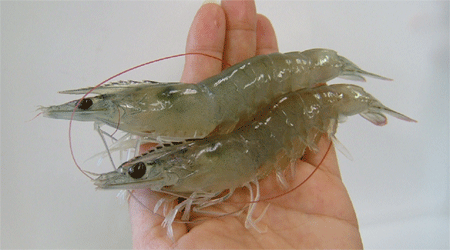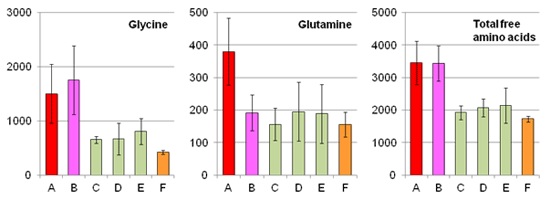Free amino acids in the muscle of whiteleg shrimp, iLitopenaeus vannamei, reared under a closed, recirculating production system
Description
The world’s total production of marine shrimp has increased drastically in recent years. However, in Asian countries which produce approximately 75% of the total amount, coastal shrimp farming has brought about environmental problems such as the destruction of mangroves due to large-scale construction of shrimp ponds, or pollution of the water and soil because of the massive use of chemicals intended to prevent disease outbreaks. In order to address these problems and establish sustainable shrimp production, JIRCAS and International Mariculture Technology Co. Ltd. have developed the novel “Indoor Shrimp Production System (ISPS)” using land-based recirculating aquaculture technology. In ISPS, whiteleg shrimp (Litopenaeus vannamei) are reared to market size in low salinity water (5 ppt) in order to reduce rearing costs. However, in general, crustaceans show decreased free amino acid (FAA) levels in the muscle under low salinity conditions, which may thereby lower their value as a food product, as FAAs are important factors influencing the taste of the marine products. In the present study, FAAs were analyzed in the muscle of L. vannamei produced by ISPS (ISPS-whiteleg shrimp), and in other commercially cultured shrimp species, e.g., kuruma prawn (Marsupenaeus japonicus) produced domestically in Japan, giant tiger prawn (Penaeus monodon) imported from Vietnam, Indian prawn (Fenneropenaeus indicus) from the Kingdom of Saudi Arabia, Pacific blue shrimp (L. stylirostris) from New Caledonia, and whiteleg shrimp (L. vannamei) imported from Indonesia.
Analysis using high performance liquid chromatography revealed that ISPS-whiteleg shrimp (Fig. 1) showed high levels of total free amino acids (the sum of 19 free amino acids examined in this study), and key FAAs including glycine and glutamine. These levels were similar to those of kuruma prawn produced domestically in Japan, but higher than those of imported shrimp species (Fig. 2). These results demonstrate that a high-value shrimp destined for human consumption can be produced by ISPS. In addition, ISPS-whiteleg shrimp have been highly evaluated on the domestic market.
Based on the fact that ISPS can be established inland without using chemicals and depending on the use of fresh seawater, ISPS can minimize impact to the environment. Moreover, the present study shows that ISPS can produce a high-value product for the market. Though some modifications may be necessary to adopt it for use overseas, including the developing regions, the advantages of ISPS as discussed above have promise to contribute to the establishment of sustainable shrimp production industries.
Figure, table
-
Fig. 1. Litopenaeus vannamei produced by ISPS -
Fig. 2. Free amino acids (glycine, glutamine, and total free amino acids) in the muscle of shrimps of the Penaeidae family (mg/ 100g)A. ISPS-whiteleg shrimp (Litopenaeus vannamei)
B. Kuruma prawn (Marsupenaeus japonicus) produced in Japan
C. Giant tiger prawn (Penaeus monodon) imported from Vietnam
D. Indian prawn (Fenneropenaeus indicus) imported from the Kingdom of Saudi Arabia
E. Pacific blue shrimp (L. stylirostris) imported from New Caledonia, France
F. Whiteleg shrimp (L. vannamei) imported from Indonesia
- Affiliation
-
Japan International Research Center for Agricultural Sciences Fisheries Division
- Term of research
-
FY2009~2011
- Responsible researcher
-
Okutsu Tomoyuki ( Fisheries Division )
KAKEN Researcher No.: 40456322SHINJI Junpei ( University of Tokyo )
NOHARA Setsuo ( International Mariculture Technology Compamy Limited )
NOMURA Takeshi ( International Mariculture Technology Compamy Limited )
MAENO Yukio ( Fisheries Division )
- ほか
- Publication, etc.
-
Okutsu, et al. (2010) Journal of Fisheries Technology. 3(1):37-41.
- Japanese PDF
-
2010_seikajouhou_A4_ja_Part15.pdf232.24 KB


